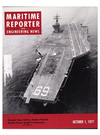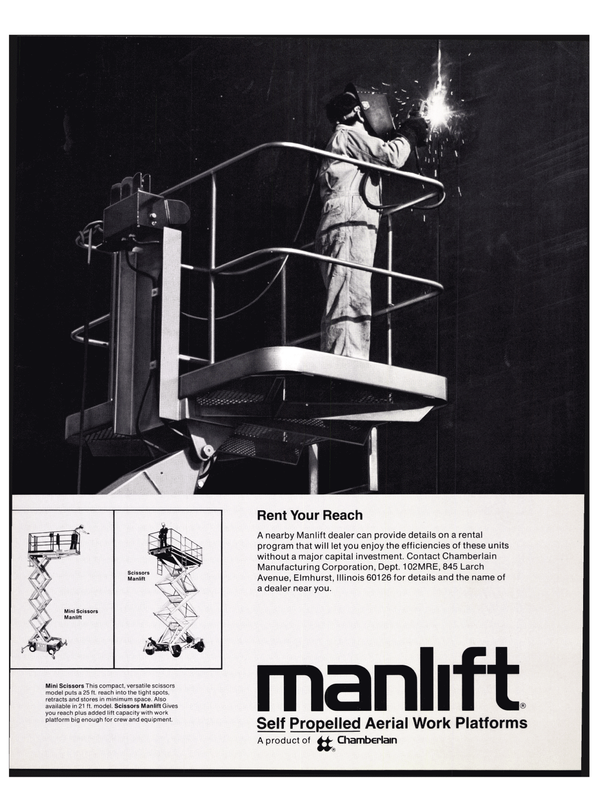
Todd To Build Santa Fe Pipelaying Vessel
Todd Shipyards Corporation and Santa Fe International Corp.
jointly announced the award of a contract to Todd for the construction of the first self-propelled pipelaying reel ship. According to E.L. Shannon Jr., Santa Fe president, the vessel will cost approximately $28,000,000, including owner-furnished equipment, and it will be built at Todd's Galveston (Texas) Division for delivery in the second half of 1978.
The dynamically positioned vessel, to be named Apache, is designed to lay steel pipe from 4 to 16 inches in diameter in prewelded strings from 7 to 50 miles long. Overall length will be 389 feet 3 inches, breadth 70 feet, and the vessel will be powered by two diesel engines with 7,200 total hp, providing cruising radius of 5,000 miles.
The decision to build the ship followed more than two years of design, planning and market analysis.
The Apache will incorporate some of the patented features of Santa Fe's Chickasaw, a smaller, n o n s e l f - p r o p e l l e d reel barge which, since its construction in 1970, has laid nearly 6,000 miles of oil and gas pipelines up to 12 inches in diameter.
The Apache will be able to cruise at speeds of 12.5 knots for marine pipelaying projects in any part of the world. Traveling under its own power, it will be capable of unreeling pipe off the stern at speeds of 1.5 to 2 knots.
Its reel, turning on a horizontal axis, will feed the pipe onto a vertically adjustable ramp having a built-in hydraulic pipe straightener.
With the ramp raised to its maximum height, the ship can lay pipe in water as much as 2,000 feet deep for 16-inch-diameter lines and to 3,000 feet deep for smaller lines; in either case much deeper than any marine pipelines previously laid on a commercial basis. The adjustable pipe ramp also will eliminate the need for a stinger, an appendage to the lay vessel which is normally required to prevent buckling of the pipe as it descends to the seabed in deep water.
Measuring 83 feet high, the reel will have a hub diameter of 54 feet and a width of 22 feet between the outside flanges. It will carry up to 2,000 short tons of pipe, with a full load varying from 265,000 feet (50 miles) of 4-inch pipe to 140,000 feet of 6-inch, 92,000 feet of 8-inch, 60,000 feet of 12-inch, or 37,000 feet of 16-inch. The vessel also may carry any combination of these sizes on one voyage.
The Apache is designed to meet all rules and registration requirements of the U.S. Coast Guard, the American Bureau of Shipping, and the latest SOLAS (Safety of Life at Sea) conventions to qualify it for full ocean rating and to permit registry under the U.S.
flag.
Capable of all-season operations in North Sea-type conditions, the vessel will be able to lay a load of pipe during a brief interval between storms in almost any ocean environment. According to design criteria, the vessel would be able to continue laying pipe while subjected to a combination roll of 5 degrees to each side, a double amplitude pitch of 5 degrees, and a total heave of 6 feet in 12-second cycles.
It will be equipped with a saturation diving system to support working dives in water depths to 1,000 feet.
Four thrusters, two each at the bow and the stern, will help maintain position of the vessel during pipelaying and retrieval operations.
These thrusters will be individually driven by electric motor for computer-controlled automatic positioning.
In operation, the Apache will anchor at a coastal base while pre-welded strings of pipe are wound onto the reel and joined together. When loaded, it will sail to the designated site and unreel the pipe. If more than one load is required for a job, the line will be temporarily plugged and laid on the seabed until the vessel returns with more pipe.
The reeling system eliminates all offshore pipeline welding except at the tie-ins where the line connects with a previously laid string or with another installation.
It also permits X-raying of the yard welds and hydrostatic testing of the pipe before the vessel leaves port.
Since much of the pipeline work is done on shore, the Apache will have quarters for only 120 persons, about half the crew on a conventional pipelaying vessel.
The normal complement aboard the Apache would total 85 persons assigned to the pipelaying operation, including inspectors and customer's representatives, plus a ship's crew of 35.
Home base of the Apache while operating in the Gulf of Mexico will be at Houma, La. This is the site of Santa Fe's pipespooling yard currently used by the Chickasaw, and also is the Gulf Coast operations headquarters for the company's drilling, construction and diving organizations.
Read Todd To Build Santa Fe Pipelaying Vessel in Pdf, Flash or Html5 edition of October 1977 Maritime Reporter
Other stories from October 1977 issue
Content
- Ocean Orders Three Cargo Liners From British Shipyard page: 4
- $11-Million Award To Raymond Int'l For Dock Work In Nigeria page: 4
- Shipyards Will Bid On Matzer-Designed Ro/Ro Containership page: 6
- James A. Farrell Jr. Receives Admiral Of The Ocean Sea (AOTOS) Award page: 6
- Bethlehem Beaumont To Build Teledyne Drilling Platform page: 6
- Newport News Lays Keel For First ULCC In $418-Million Contract page: 6
- Chesapeake Corporation Names Elmer Curfman Marine Superintendent page: 7
- LNG Shipping— What Prospects Now? page: 8
- Newport News Delivers Nuclear-Powered Aircraft Carrier Dwight D. Eisenhower page: 10
- American Bureau Of Shipping Elects Johnston President page: 10
- DeLong Corporation Appoints Ogden Chief Engineer page: 10
- Dockside To Represent Burmeister & Wain In Southern California page: 11
- Sun Company Names Maling Vice President page: 11
- Atlantic Sandblasting Receives Fourteen-Ship Mexican Contract page: 12
- Bethlehem Steel Names Thomas Robinson To Central Technical Post page: 14
- Paul Atkinson Retires, Peter Hepp Elected Sun Ship President page: 14
- Todd To Build Santa Fe Pipelaying Vessel page: 15
- OCEANS '77 Conference Set For October 17-18-19 page: 16
- Hitachi Delivers 508,731-DWT Esso Atlantic —Largest Ship Ever Built In Japan page: 18
- Alco Power Southwest Headquarters In New And Larger Houston Location page: 18
- Zapata Names Four Senior Executives To New Posts page: 18
- Booklet Describes Vinyl Coatings For Corrosion Control page: 18
- Crowley Subsidiary Awarded $39-Million Cool Barge Contract page: 20
- ABS President Foresees Trend Toward Nuclear Merchant Ships By 1990 page: 21
- Oosterhuis Industries Supplies American Brons Diesel Engines To Five New Offshore Tugs Ship Buying Spree page: 22
- Carrington Launches Self-Unloading Cement Carrier page: 22
- Bird-Johnson Appoints National And Regional Sales Managers page: 23
- Ro/Ro Shipping-An Appraisal Of Its Role In Dry Cargo Trade page: 24
- Leif Hoegh Orders Two Multipurpose Ships From Japanese Yard page: 25
- Hyundai Shipbuilding Licensed To Build B&W Diesel Engines page: 25
- Chinese On Worldwide Ship Buying Spree page: 26
- Senior USCG Advisor Robert Lakey Joins Helge Ringdal, Inc. page: 26
- Five Companies Form Technology Group To Build Canadian Ships page: 27
- Intermarine Brochure Fully Describes New Marine Radar page: 28
- Shipowners Seek To Enjoin Alaska State Tanker Law page: 28
- Avondale Launches 165,000-DWT Tanker For Standard Oil (Ohio) Alaskan Service page: 29
- R.E. Derecktor Delivers Tug To Great Lakes Dredge & Dock Co. page: 30
- Northeast Marine Terminal Announces Start Of Affiliate Operation In Savannah, Ga. page: 31
- American President Lines Names Capt. E.J. McClafferty page: 31
- Maine Maritime Academy Shipping Management Seminar Labeled Outstanding Success page: 32
- Nuclear Merchant Ship Environmental Impact Analysis Published page: 34
- Paper On Drydock Designs Presented At San Diego Meeting page: 34
- Schneider And Moody Named To New Posts At Moore-McCormack Lines page: 34
- Burmeister & Wain Opens Marine Service Center In Hong Kong page: 34
- Packet Offered On Hiring Filipino Seamen page: 35
- Prudential Lines Names Captain George Evans page: 35
- Brochure Describes Removal Of Smoke From Air Vents page: 35
- Maritime Industry Metric Conversion Study Is Available page: 36
- Interocean Conducts Inert Gas Course page: 36
- Gotaverken Delivers Third Tanker For Iraq page: 36
- Crossocean Shipping Names Thomas Giardino page: 36
- Johnston Vertical Pumps Names Hoffert Marine page: 36
- MarAd To Study Liner Segment Of U.S. Merchant Fleet page: 37
- United States Lines Names Capt. Yarborough Assistant Marine Supt. page: 39
- Varo Names Johnson Marine Coordinator page: 39
- American Club Triples Tonnage In Five Years page: 39
- Device Prevents Cable From Becoming Tangled With Buoy Lines page: 42
- Sea Power Symposium Set For Los Angeles November 4, 1977 page: 42
- MarAd Releases 15 Technical Reports On Gas Turbines page: 42
- Bath Iron Works Appoints Igo Jekkals page: 43
- Webb Institute Receives Grant For Research Facilities page: 43
- Mechling States All Modes Necessary For Sound System page: 44
- Gonsoulin Industries New Mother Company For LeBeouf Towing page: 44
- ABS Reports Increase In Classifications page: 44
- APL Team To Analyze Systems Controlling Steam Plants On Ships page: 45
- Campbell Delivers Second Offshore Vessel To Biehl page: 46
- Stow Introduces New Remote Valve Control Flexible Shaft page: 46
- U.S. Navy Officers Assigned To Kings Point page: 46
- Owners Strongly Oppose Federal Financing Bank Control Of Title XI page: 47
- World's First Naval Exposition Set For Netherlands June '78 page: 48
- Eleven New Members Elected To American Bureau Of Shipping page: 48
- CCL Shipcare Limited New Marine Service page: 48
- Camar Develops Blowers Designed For Shipboard Inlet Gas Systems page: 50
- New Maritime Firm Port Fabricators, Inc. Active In Louisiana page: 50
- Report Shows 101 Plants Locate Waterside In First Quarter Of 1977 page: 51
- Edwin G.B. Terry Joins Tidewater Marine Service page: 53
- Waterproofed Engines On Self-Righting Lifeboat Restart Following Capsize page: 53
- Port Of St. Louis Propeller Club Elects Robert Patrick page: 54
- Lloyd's Register Announces Major Changes For 1978 page: 54
- Maxon Marine Industries Delivers Specially Designed Towboat To J.L. Shiely Company page: 55
- SNAME Publishes 'Gas Trials Guide For LNG Vessels' page: 55
- DeLong Jack Systems Described In Brochure page: 55
- James J. Bolton Elected President Jered Industries page: 56
- North American Philips Offers New Radio Telex System For Shipboard Communications page: 58
- Mangone Delivers 185-Foot Supply Vessel To Briley page: 58
- Britain's P&O Group Designs New Type Naval Vessel To Be Built In Private Yards page: 60
- Equitable Lays Keel For First Of Three Breakbulk Vessels For American Atlantic Shipping page: 60
- Study Of Superports And SBMs For Tankers Published page: 63
- Blue Water Marine Forms New Division —George Gray Named page: 64
- Buenos Aires And Manila Added To ABS Network Of Technical Offices page: 64
- American Heavy Lift Shipping Company Names Two Top Executives page: 64
- W.L. Bull Jr. Named Marine Transportation Director For NLFI page: 65
- Marco's 25th Crabber Readied For King Crab Season Opening page: 66


